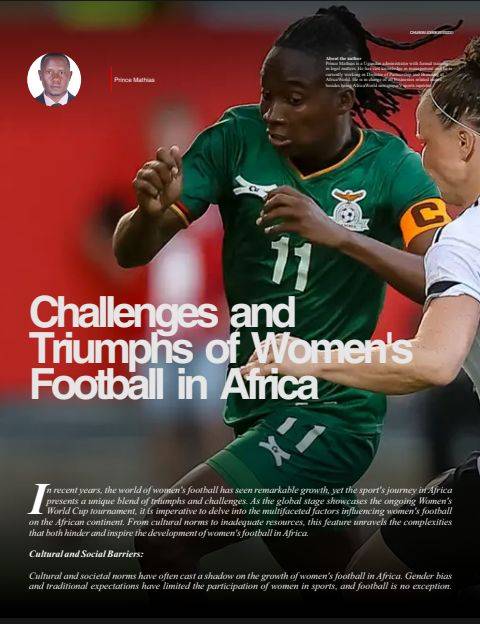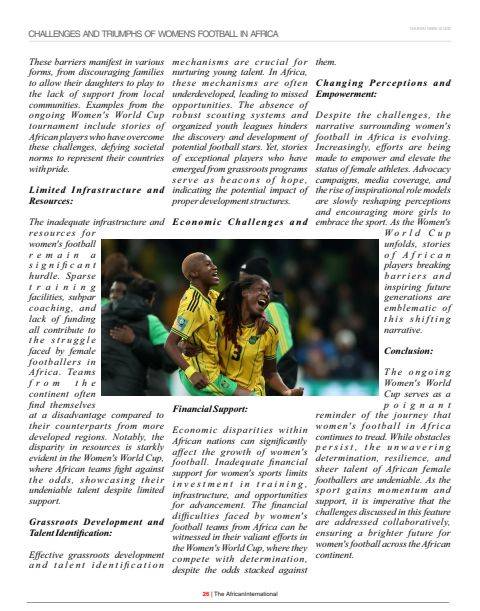By Prince Mathias

Challenges and Triumphs of Women’s Football in Africa- The African International Magazine-July, August ed
In recent years, the world of women’s football has seen remarkable growth, yet the sport’s journey in Africa presents a unique blend of triumphs and challenges. As the global stage showcases the ongoing Women’s World Cup tournament, it is imperative to delve into the multifaceted factors influencing women’s football on the African continent. From cultural norms to inadequate resources, this feature unravels the complexities that both hinder and inspire the development of women’s football in Africa.
Cultural and Social Barriers:
Cultural and societal norms have often cast a shadow on the growth of women’s football in Africa. Gender bias and traditional expectations have limited the participation of women in sports, and football is no exception. These barriers manifest in various forms, from discouraging families to allow their daughters to play to the lack of support from local communities. Examples from the ongoing Women’s World Cup tournament include stories of African players who have overcome these challenges, defying societal norms to represent their countries with pride.
Limited Infrastructure and Resources:
The inadequate infrastructure and resources for women’s football remain a significant hurdle. Sparse training facilities, subpar coaching, and lack of funding all contribute to the struggle faced by female footballers in Africa. Teams from the continent often find themselves at a disadvantage compared to their counterparts from more developed regions. Notably, the disparity in resources is starkly evident in the Women’s World Cup, where African teams fight against the odds, showcasing their undeniable talent despite limited support.
Grassroots Development and Talent Identification:
Effective grassroots development and talent identification mechanisms are crucial for nurturing young talent. In Africa, these mechanisms are often underdeveloped, leading to missed opportunities. The absence of robust scouting systems and organized youth leagues hinders the discovery and development of potential football stars. Yet, stories of exceptional players who have emerged from grassroots programs serve as beacons of hope, indicating the potential impact of proper development structures.
Economic Challenges and Financial Support:
Economic disparities within African nations can significantly affect the growth of women’s football. Inadequate financial support for women’s sports limits investment in training, infrastructure, and opportunities for advancement. The financial difficulties faced by women’s football teams from Africa can be witnessed in their valiant efforts in the Women’s World Cup, where they compete with determination, despite the odds stacked against them.
Changing Perceptions and Empowerment:
Despite the challenges, the narrative surrounding women’s football in Africa is evolving. Increasingly, efforts are being made to empower and elevate the status of female athletes. Advocacy campaigns, media coverage, and the rise of inspirational role models are slowly reshaping perceptions and encouraging more girls to embrace the sport. As the Women’s World Cup unfolds, stories of African players breaking barriers and inspiring future generations are emblematic of this shifting narrative.
Conclusion:

The ongoing Women’s World Cup serves as a poignant reminder of the journey that women’s football in Africa continues to tread. While obstacles persist, the unwavering determination, resilience, and sheer talent of African female footballers are undeniable. As the sport gains momentum and support, it is imperative that the challenges discussed in this feature are addressed collaboratively, ensuring a brighter future for women’s football across the African continent.

